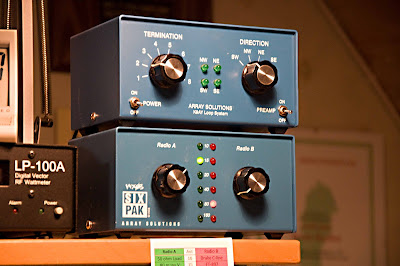ZL7G was on 160 and I did put in a lot of effort to hear them and finally work them. But NIL. One day I heard some faint fragments but not enough to start calling them. A few SM stations was Calling and I wonder how they could hear him. I use a K9AY Array and the noise here in the forest is low. So it would be nice to knew what the h..k these hams are using for RX antennas.
This chase was an on going procedure. But I did not hear a single "pip" from ZL7G on 160 any more.
Here you can see my Control head for my K9AY Loop Array. As the noise level here in the middle of forest is very low. I normally hear the DX well. But my TX antenna is some kind of compromise as I use a 24 m vertical with linear loading creating an electrical length of 36 m. And together with a lading coil I get it to show low SWR on 160 m. I have about 2,4 km radials.
But it would be nice to see what these guys that make QSO with rare DX on 160 m are using.
I made an astonishing Discovery! I was out on the web searching for SDR. Found one in Australia. On this SDR I heard ZL7G with 599 Sig's!! On this SDR all users was shown either with call used or IP addresses as you have to log in. BUSTED!!! Now I could hear the perfect timing of some EU stations Calling ZL7G. But on my K9AY there was NIL Sig's. So this is how it is done!!?? What is the value of a such QSO when you don't hear the DX at your location? Is DXCC losing it's value? Is the effort for being in the top of all lists so big that you have to take such measures to achieve this? I will not say the word "cheating" but it is close in my world. I like to hear the DX at my location and work it in that manner. But modern technique has made this possible. And there are a lot of SDR's out there. I might be old fashion but I stick to hear the station in my RX when I'm trying to work them. So if I don't hear them I can't work them.
CUL

No comments:
Post a Comment